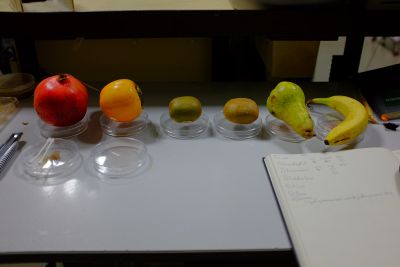GMU:DIY Bio: doing things with biology/Nyiko Johannes Mucavele: Difference between revisions
| Line 1: | Line 1: | ||
== The effects of Ethylene Gas on fruits == | == The effects of Ethylene Gas on fruits == | ||
'One bad apple spoils the bunch' is a saying commonly used to imply that misdemeanants can rub off their negative behaviour onto their nearby peers. However this is also used in a literal sense in that fruits being close to one another causes faster ripening thus bringing faster rotting. This can come as a result of a spreading fungus of some sort but more interestingly as a result of ethylene gas.Ethylene gas is produced by fruits (and vegetables) and guides the ripening and rotting of a fruit. The gas is typically released in higher quantity in more matured fruits. | |||
Ethylene gas is used to control the maturity of fruits in commercial spaces but cannot be found to order online on mainstream sites from what I've seen. A form of application for the knowledge of fruit-ethylene gas interactions would be a good point to close the topic on. | |||
One goal of such a thing could be to raise awareness on fruit storage, to bring tangible evidence of fruit interaction to people and encourage positive fruit storage habits. Things such as which fruits to keep together and apart for better ripening or longer preservation. This knowledge of organizing fruits (and vegetables) for preferable outcomes seems limited to the dedicated gardening communities by lack of interest elsewhere but could definitely come in handy for more people. | |||
I would think that through photographic representation accompanied by short texts of these ethylene fruit interactions the information would catch more interest. For every person who actively preserves their foods a little bit better there is one less food item that will be thrown out because it looks a little bit overly-ripe. | |||
A convenient collection of data relating to fruit release rates and sensitivities to ethylene gas that I have used: https://www.mykitchengarden.info/2016/10/fruits-vegetables-producing-ethylene-or-sensitive.html | A convenient collection of data relating to fruit release rates and sensitivities to ethylene gas that I have used: https://www.mykitchengarden.info/2016/10/fruits-vegetables-producing-ethylene-or-sensitive.html | ||
Revision as of 01:32, 6 April 2019
The effects of Ethylene Gas on fruits
'One bad apple spoils the bunch' is a saying commonly used to imply that misdemeanants can rub off their negative behaviour onto their nearby peers. However this is also used in a literal sense in that fruits being close to one another causes faster ripening thus bringing faster rotting. This can come as a result of a spreading fungus of some sort but more interestingly as a result of ethylene gas.Ethylene gas is produced by fruits (and vegetables) and guides the ripening and rotting of a fruit. The gas is typically released in higher quantity in more matured fruits.
Ethylene gas is used to control the maturity of fruits in commercial spaces but cannot be found to order online on mainstream sites from what I've seen. A form of application for the knowledge of fruit-ethylene gas interactions would be a good point to close the topic on.
One goal of such a thing could be to raise awareness on fruit storage, to bring tangible evidence of fruit interaction to people and encourage positive fruit storage habits. Things such as which fruits to keep together and apart for better ripening or longer preservation. This knowledge of organizing fruits (and vegetables) for preferable outcomes seems limited to the dedicated gardening communities by lack of interest elsewhere but could definitely come in handy for more people.
I would think that through photographic representation accompanied by short texts of these ethylene fruit interactions the information would catch more interest. For every person who actively preserves their foods a little bit better there is one less food item that will be thrown out because it looks a little bit overly-ripe.
A convenient collection of data relating to fruit release rates and sensitivities to ethylene gas that I have used: https://www.mykitchengarden.info/2016/10/fruits-vegetables-producing-ethylene-or-sensitive.html
